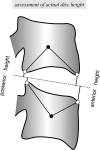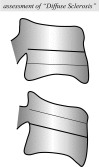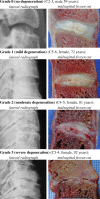Validity and interobserver agreement of a new radiographic grading system for intervertebral disc degeneration: Part II. Cervical spine
- PMID: 16614855
- PMCID: PMC3489447
- DOI: 10.1007/s00586-005-1037-9
Validity and interobserver agreement of a new radiographic grading system for intervertebral disc degeneration: Part II. Cervical spine
Abstract
A new radiographic grading system for a more objective assessment of lumbar intervertebral disc degeneration has been described and tested in Part I of this study. The aim of the present Part II of the study was to adapt this system to the cervical spine, and to test it for validity and interobserver agreement. Some modifications of the grading system described in Part I were necessary to make it applicable to the cervical spine. Its basic structure, however, stayed untouched. The three variables "Height Loss", "Osteophyte Formation" and "Diffuse Sclerosis" first have to be graded individually. Then, the "Overall Degree of Degeneration" is assigned on a four-point scale from 0 (no degeneration) to 3 (severe degeneration). For validation, the radiographic degrees of degeneration of 28 cervical discs were compared to the respective macroscopic ones, which were defined as "real" degrees of degeneration. The interobserver agreement was determined between one experienced and one unexperienced observer using the radiographs of 57 cervical discs. Quadratic weighted Kappa coefficients (kappa) with 95% confidence limits (95% CL) were used for statistical evaluation. The validation of the new version of the radiographic grading system showed a moderate agreement with the "real", macroscopic overall degree of degeneration (kappa=0.599, 95% CL 0.421-0.786). In 64% of all discs the "real" overall degree of degeneration was underestimated but never overestimated. This underestimation, however, was much less pronounced and the Kappa coefficients were significantly higher for the three variables: Height Loss, Osteophyte Formation, and Diffuse Sclerosis separately. The agreement between the radiographic ratings of the experienced and the unexperienced observer was substantial for the overall degree of degeneration (kappa=0.688, 95% CL 0.580-0.796), almost perfect for the variable, Height Loss, moderate for Osteophyte Formation and fair for Diffuse Sclerosis. In conclusion, we believe that the new version of the radiographic grading system is a sufficiently valid and reliable tool to quantify the degree of degeneration of individual cervical intervertebral discs. In comparison to the version for the lumbar spine described in Part I, however, a slightly higher tendency to underestimate the "real" overall degree of degeneration and somewhat higher interobserver differences have to be expected.
Figures





Similar articles
-
Validity and interobserver agreement of a new radiographic grading system for intervertebral disc degeneration: Part I. Lumbar spine.Eur Spine J. 2006 Jun;15(6):720-30. doi: 10.1007/s00586-005-1029-9. Epub 2005 Nov 18. Eur Spine J. 2006. PMID: 16328226 Free PMC article.
-
Validity and interobserver agreement of a new radiographic grading system for intervertebral disc degeneration: Part III. Thoracic spine.Eur Spine J. 2022 Mar;31(3):726-734. doi: 10.1007/s00586-021-06970-6. Epub 2021 Aug 30. Eur Spine J. 2022. PMID: 34460004
-
Qualitative and quantitative assessment of degeneration of cervical intervertebral discs and facet joints.Eur Spine J. 2009 Mar;18(3):358-69. doi: 10.1007/s00586-008-0820-9. Epub 2008 Nov 13. Eur Spine J. 2009. PMID: 19005690 Free PMC article.
-
Review of existing grading systems for cervical or lumbar disc and facet joint degeneration.Eur Spine J. 2006 Jun;15(6):705-18. doi: 10.1007/s00586-005-0954-y. Epub 2005 Sep 20. Eur Spine J. 2006. PMID: 16172902 Free PMC article. Review.
-
Radiographic evaluation of the degenerative cervical spine.Orthop Clin North Am. 1992 Jul;23(3):395-403. Orthop Clin North Am. 1992. PMID: 1620534 Review.
Cited by
-
The Diagnostic Value of an X-ray-based Scoring System for Degeneration of the Cervical Spine: A Reproducibility and Validation Study.Pain Pract. 2021 Sep;21(7):766-777. doi: 10.1111/papr.13013. Epub 2021 May 18. Pain Pract. 2021. PMID: 33837629 Free PMC article.
-
Impact of neck posture and insulating stick use on neck disability in Korean line workers: a cross-sectional study.Ann Occup Environ Med. 2024 Apr 15;36:e11. doi: 10.35371/aoem.2024.36.e11. eCollection 2024. Ann Occup Environ Med. 2024. PMID: 38741681 Free PMC article.
-
Bone mineral density, cervical spine degeneration, head and neck posture, and neck pain in the post-menopausal females: A pilot study.PLoS One. 2021 Sep 20;16(9):e0257735. doi: 10.1371/journal.pone.0257735. eCollection 2021. PLoS One. 2021. PMID: 34543361 Free PMC article.
-
In-vivo T2-relaxation times of asymptomatic cervical intervertebral discs.Skeletal Radiol. 2016 Mar;45(3):393-400. doi: 10.1007/s00256-015-2307-1. Epub 2015 Dec 7. Skeletal Radiol. 2016. PMID: 26643385 Free PMC article.
-
Evaluation of a new approach to compute intervertebral disc height measurements from lateral radiographic views of the spine.Eur Spine J. 2017 Jan;26(1):167-172. doi: 10.1007/s00586-016-4817-5. Epub 2016 Oct 18. Eur Spine J. 2017. PMID: 27757680 Free PMC article.
References
-
- Brooker AE, Barter RW. Cervical spondylosis. a clinical study with comparative radiology. Brain. 1965;88(5):925–936. - PubMed
-
- Collins DH (1949) The pathology of articular and spinal diseases. Edward Arnold & Co, London
-
- Fleiss J, Cohen J. The equivalence of weighted kappa and the intraclass correlation coefficient as measures of reliability. Educ Psychol Meas. 1973;33:613–619.
Publication types
MeSH terms
LinkOut - more resources
Full Text Sources
Medical

